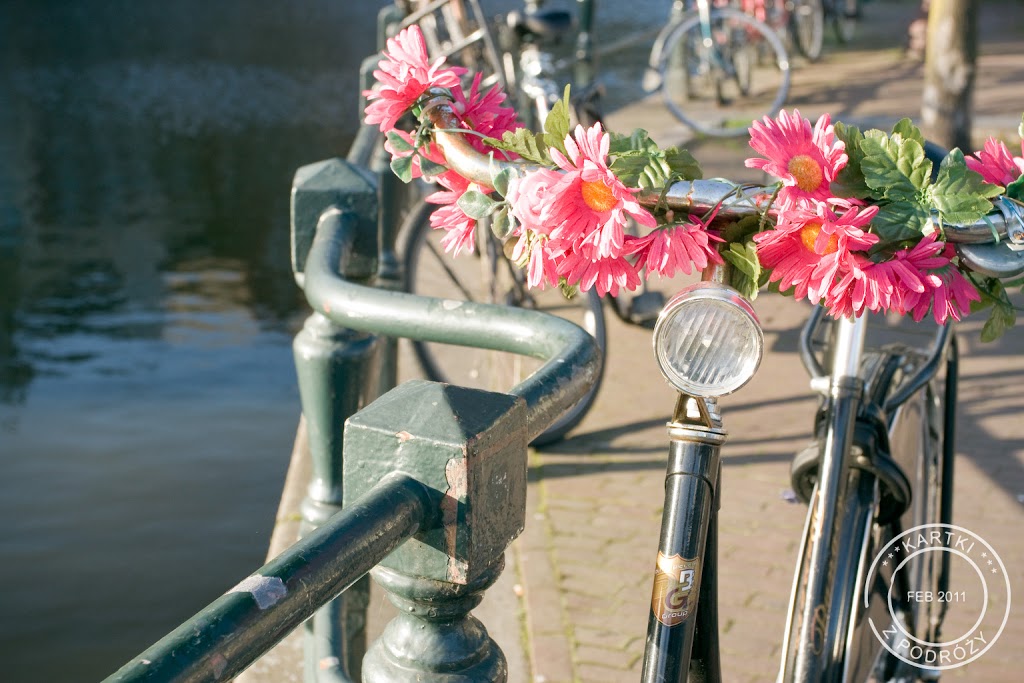[for English scroll down]
Osiem godzin w Amsterdamie to zdecydowanie za krótko, żeby odwiedzać muzea. Czasu nie wystarczy też, żeby przysiąść na bucha w coffee shopie. To zaledwie chwila na „szybki” spacer wzdłuż kanałów oraz alejkami dzielnicy Czerwonych Latarni, po to aby poczuć atmosferę miasta. Miasta, które na pierwszy rzut oka do złudzenia przypomina mi Kopenhagę.
Diamentowe miasto
Amsterdam – miasto kanałów, coffee shopów, tulipanów, rowerów. To także, a może nawet przede wszystkim stolica Holandii – ojczyzny tak wielkich malarzy jak Van Gogh czy Rembrandt. Znajdziesz tu malownicze kamienice ustawione na baczność wzdłuż sieci kanałów, urocze mosty, kolorowe łodzie, czy majestatyczne łabędzie. Jeśli trafisz do słynnej Dzielnicy Czerwonych Latarni, nie zdziw się, jeśli ujrzysz półnagie dziewczęta wijące się kusząco w witrynach domów publicznych. Szerokim łukiem omijaj sklepy z tandetnymi pamiątkami, próbującymi nietrafnie oddać klimat tego miasta. Bo czy herbata z marihuaną albo rastafariańskie motywy kojarzą się z Amsterdamem? Nie, jeśli uważniej przyjrzysz się niektórym faktom historycznym dotyczącym miasta. Bo Amsterdam to również do niedawna ojczyzna diamentów.
Przez ponad cztery stulecia główne centrum przemysłu diamentowego mieściło się w Amsterdamie. W drugiej połowie XVIII wieku miasto stało się światową stolicą diamentów. Warto wspomnieć, że duży udział w diamentowym biznesie miała społeczność żydowska.
Pierwsza Wojna Światowa, Wielki Kryzys lat 30-tych oraz deportacje ludności żydowskiej w czasach Drugiej Wojny Światowej były fatalne w skutkach dla diamentowego przemysłu. Od ok. 1965 po dziś dzień, Amsterdam pozostaje jedynie miejscem handlu detalicznego tym najszlachetniejszym z minerałów.
Trochę o diamencie...
Początkowo wierzono, że diamenty rodzą się w ziemi z nasion. Przypuszcza się, że pierwszy diament znaleziono w Indiach na 1000 lat przed narodzeniem Chrystusa. Aż do XVIII wieku Indie były głównym dostawcą surowca. Dziś wiadomo, że surowiec ten występuje na wszystkich kontynentach, za wyjątkiem Europy i Antarktydy.
Zaledwie 20% wydobytych zasobów znajduje zastosowanie w przemyśle biżuteryjnym, resztę diamentów zużywa się w przemyśle. Ciekawostką jest, że diamentowe ostrza stosuje się w narzędziach używanych w medycynie estetycznej.
8 hours in Amsterdam is definitely to short to visit museums. It is also not enough to chill out in coffee shop and try marijuana stuff. It’s just a moment for quick walk around channels and exploration of Red Lantern District – just to feel the atmosphere of the city. The city that at first glance remind me Copenhagen.
Diamond City
In short, it can be said that Amsterdam is the city of channels, tulips and bikes; and also, this place is well known for its liberal attitude toward weed smokers, but first and foremost it is a capital of the Netherlands – motherland of great artist such like Van Gogh or Rembrandt. You can also find beautiful houses standing along channels, adorable bridges, boats and swans. Don’t be surprised if you see a half-naked stripper in the window of whore-house in the Red Lanterns District. If you really want to feel the atmosphere of Amsterdam, omit souvenir shops.
Why? Do you really think that marijuana tea or Rasta motifs represent the city? Not everybody knows that for more than four centuries, the diamond industry was established in Amsterdam. In the second half of the 17th century Amsterdam became the diamond capital of the world. The city long remained an important center of polishing and trading. It is worth to mention that major impact on diamond business on that time had Jewish citizens.
The First World War, the Depression of Thirties and above all the deportation of the Jewish population in the Second World War were fatal to the diamond industry in Amsterdam. Since around 1965, Amsterdam has mostly been a center of diamond trading, focusing particularly on sale to customer.
Something About Diamonds
Initially people believed that diamonds grow from seeds in the ground. It is assumed that first diamond was found in India, as early as 1000 BC. And India remained the most important supplier of diamonds until the 18th century. Nowadays diamonds are found in more than 20 countries throughout the world, although not on the countries of Europe or Antarctica.
Merely 20% of the total world production is used for jewelry, the rest for industrial application, i.e. as blades for its physical properties.


Jedna odpowiedź
Super fota z kościołem św. Mikołaja